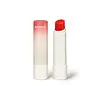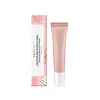What's inside
What's inside
 Key Ingredients
Key Ingredients

 Benefits
Benefits

 Concerns
Concerns

 Ingredients Side-by-side
Ingredients Side-by-side

Caprylic/Capric Triglyceride
MaskingPhytosteryl Isostearyl Dimer Dilinoleate
EmollientSimmondsia Chinensis Seed Oil
EmollientDiisostearyl Malate
EmollientHydrogenated Polyisobutene
EmollientBis-Diglyceryl Polyacyladipate-2
EmollientHydrogenated Castor Oil Dimer Dilinoleate
Skin ConditioningBeeswax
Emulsion StabilisingSynthetic Wax
AbrasiveMicrocrystalline Wax
Emulsion StabilisingPolyethylene
AbrasiveCocos Nucifera Seed Butter
Skin ConditioningTocopheryl Acetate
AntioxidantCandelilla Wax Esters
Parfum
MaskingPolyglyceryl-2 Triisostearate
EmulsifyingCopernicia Cerifera Wax
CI 17200
Cosmetic ColorantCI 77891
Cosmetic ColorantPolyglyceryl-2 Diisostearate
EmulsifyingWater
Skin ConditioningCI 77491
Cosmetic ColorantButylene Glycol
HumectantPropanediol
Solvent1,2-Hexanediol
Skin ConditioningBHT
AntioxidantNatto Gum
Glycine Soja Seed Extract
Skin ConditioningEthylhexylglycerin
Skin ConditioningDisodium EDTA
Caprylic/Capric Triglyceride, Phytosteryl Isostearyl Dimer Dilinoleate, Simmondsia Chinensis Seed Oil, Diisostearyl Malate, Hydrogenated Polyisobutene, Bis-Diglyceryl Polyacyladipate-2, Hydrogenated Castor Oil Dimer Dilinoleate, Beeswax, Synthetic Wax, Microcrystalline Wax, Polyethylene, Cocos Nucifera Seed Butter, Tocopheryl Acetate, Candelilla Wax Esters, Parfum, Polyglyceryl-2 Triisostearate, Copernicia Cerifera Wax, CI 17200, CI 77891, Polyglyceryl-2 Diisostearate, Water, CI 77491, Butylene Glycol, Propanediol, 1,2-Hexanediol, BHT, Natto Gum, Glycine Soja Seed Extract, Ethylhexylglycerin, Disodium EDTA
Diisostearyl Malate
EmollientHydrogenated Polyisobutene
EmollientDipentaerythrityl Hexa C5-9 Acid Esters
Skin ConditioningMicrocrystalline Wax
Emulsion StabilisingPolyurethane-79
Tocopheryl Acetate
AntioxidantSilica Dimethyl Silylate
EmollientParfum
MaskingEclipta Prostrata Extract
Skin ConditioningCurcuma Longa Root Extract
MaskingMelia Azadirachta Leaf Extract
Skin ConditioningMelia Azadirachta Flower Extract
Skin ConditioningCaprylyl Glycol
Emollient1,2-Hexanediol
Skin ConditioningMoringa Oleifera Seed Oil
EmollientCorallina Officinalis Extract
Skin ConditioningMelia Azadirachta Bark Extract
AntimicrobialSimmondsia Chinensis Seed Oil
EmollientOcimum Sanctum Leaf Extract
Skin ConditioningButylene Glycol
HumectantWater
Skin ConditioningCoccinia Indica Fruit Extract
Skin ConditioningAnemarrhena Asphodeloides Root Extract
Skin ConditioningAloe Barbadensis Flower Extract
EmollientSolanum Melongena Fruit Extract
Skin ConditioningFragaria Chiloensis Fruit Extract
Skin ConditioningBerberis Vulgaris Root Extract
AntimicrobialLycium Chinense Fruit Extract
AntioxidantMorus Nigra Fruit Extract
Skin ConditioningDiisostearyl Malate, Hydrogenated Polyisobutene, Dipentaerythrityl Hexa C5-9 Acid Esters, Microcrystalline Wax, Polyurethane-79, Tocopheryl Acetate, Silica Dimethyl Silylate, Parfum, Eclipta Prostrata Extract, Curcuma Longa Root Extract, Melia Azadirachta Leaf Extract, Melia Azadirachta Flower Extract, Caprylyl Glycol, 1,2-Hexanediol, Moringa Oleifera Seed Oil, Corallina Officinalis Extract, Melia Azadirachta Bark Extract, Simmondsia Chinensis Seed Oil, Ocimum Sanctum Leaf Extract, Butylene Glycol, Water, Coccinia Indica Fruit Extract, Anemarrhena Asphodeloides Root Extract, Aloe Barbadensis Flower Extract, Solanum Melongena Fruit Extract, Fragaria Chiloensis Fruit Extract, Berberis Vulgaris Root Extract, Lycium Chinense Fruit Extract, Morus Nigra Fruit Extract
Ingredients Explained
These ingredients are found in both products.
Ingredients higher up in an ingredient list are typically present in a larger amount.
1,2-Hexanediol is a synthetic liquid and another multi-functional powerhouse.
It is a:
- Humectant, drawing moisture into the skin
- Emollient, helping to soften skin
- Solvent, dispersing and stabilizing formulas
- Preservative booster, enhancing the antimicrobial activity of other preservatives
Butylene Glycol (or BG) is used within cosmetic products for a few different reasons:
Overall, Butylene Glycol is a safe and well-rounded ingredient that works well with other ingredients.
Though this ingredient works well with most skin types, some people with sensitive skin may experience a reaction such as allergic rashes, closed comedones, or itchiness.
Learn more about Butylene GlycolDiisostearyl Malate is an emollient and most often used in lip products. It comes from isostearyl alcohol, a fatty acid, and malic acid, an AHA.
As an emollient, Diisostearyl Malate helps create a thin film on your skin to trap moisture in. This helps keep your skin soft and smooth.
Hydrogenated Polyisobutene is a synthetic polymer. Polymers are compounds with high molecular weight. Hydrogenated Polyisobutene is an emollient and texture enhancer.
In one study, Hydrogenated Polyisobutene showed better skin hydration levels than Caprylic/Capric Triglyceride. As an emollient, it helps keep your skin soft and hydrated by trapping moisture in.
Hydrogenated Polyisobutene is often used as a mineral oil replacement.
Learn more about Hydrogenated PolyisobuteneMicrocrystalline Wax is created by de-oiling petroleum. It is highly refined and purified before being added to cosmetics.
Microcrystalline Wax is used to enhance the texture and create even consistency. It helps stabilize a product by preventing ingredients from separating.
Parfum is a catch-all term for an ingredient or more that is used to give a scent to products.
Also called "fragrance", this ingredient can be a blend of hundreds of chemicals or plant oils. This means every product with "fragrance" or "parfum" in the ingredients list is a different mixture.
For instance, Habanolide is a proprietary trade name for a specific aroma chemical. When used as a fragrance ingredient in cosmetics, most aroma chemicals fall under the broad labeling category of “FRAGRANCE” or “PARFUM” according to EU and US regulations.
The term 'parfum' or 'fragrance' is not regulated in many countries. In many cases, it is up to the brand to define this term.
For instance, many brands choose to label themselves as "fragrance-free" because they are not using synthetic fragrances. However, their products may still contain ingredients such as essential oils that are considered a fragrance by INCI standards.
One example is Calendula flower extract. Calendula is an essential oil that still imparts a scent or 'fragrance'.
Depending on the blend, the ingredients in the mixture can cause allergies and sensitivities on the skin. Some ingredients that are known EU allergens include linalool and citronellol.
Parfum can also be used to mask or cover an unpleasant scent.
The bottom line is: not all fragrances/parfum/ingredients are created equally. If you are worried about fragrances, we recommend taking a closer look at an ingredient. And of course, we always recommend speaking with a professional.
Learn more about ParfumThis oil comes from the seeds of the desert shrub called Jojoba. It is more commonly known as jojoba oil, a non-comedogenic oil.
Jojoba oil does not contain fragrance and has many fatty-acids, making it a great soothing ingredient.
It also contains Vitamin E, a great moisturizing ingredient. Vitamin E is also an antioxidant and protects your skin against oxidative damage.
This ingredient humectant properties, meaning it helps draw moisture from the air. This helps keep your skin hydrated.
While jojoba has antibacterial properties, it is only able to kill some strains of bacteria.
Studies also show it helps in wound healing. In fact, Indigenous cultures have used jojoba as a moisturizer and to help treat burns for centuries.
Fun fact: Jojoba oil similar to natural human skin sebum, so it has a great effect on dry skin. It is also promising with helping to regulate sebum production.
Due to its fatty acid content, Jojoba oil may not be fungal acne safe. We recommend speaking with a professional if you have any concerns.
Learn more about Simmondsia Chinensis Seed OilTocopheryl Acetate is AKA Vitamin E. It is an antioxidant and protects your skin from free radicals. Free radicals damage the skin by breaking down collagen.
One study found using Tocopheryl Acetate with Vitamin C decreased the number of sunburned cells.
Tocopheryl Acetate is commonly found in both skincare and dietary supplements.
Learn more about Tocopheryl AcetateWater. It's the most common cosmetic ingredient of all. You'll usually see it at the top of ingredient lists, meaning that it makes up the largest part of the product.
So why is it so popular? Water most often acts as a solvent - this means that it helps dissolve other ingredients into the formulation.
You'll also recognize water as that liquid we all need to stay alive. If you see this, drink a glass of water. Stay hydrated!
Learn more about Water